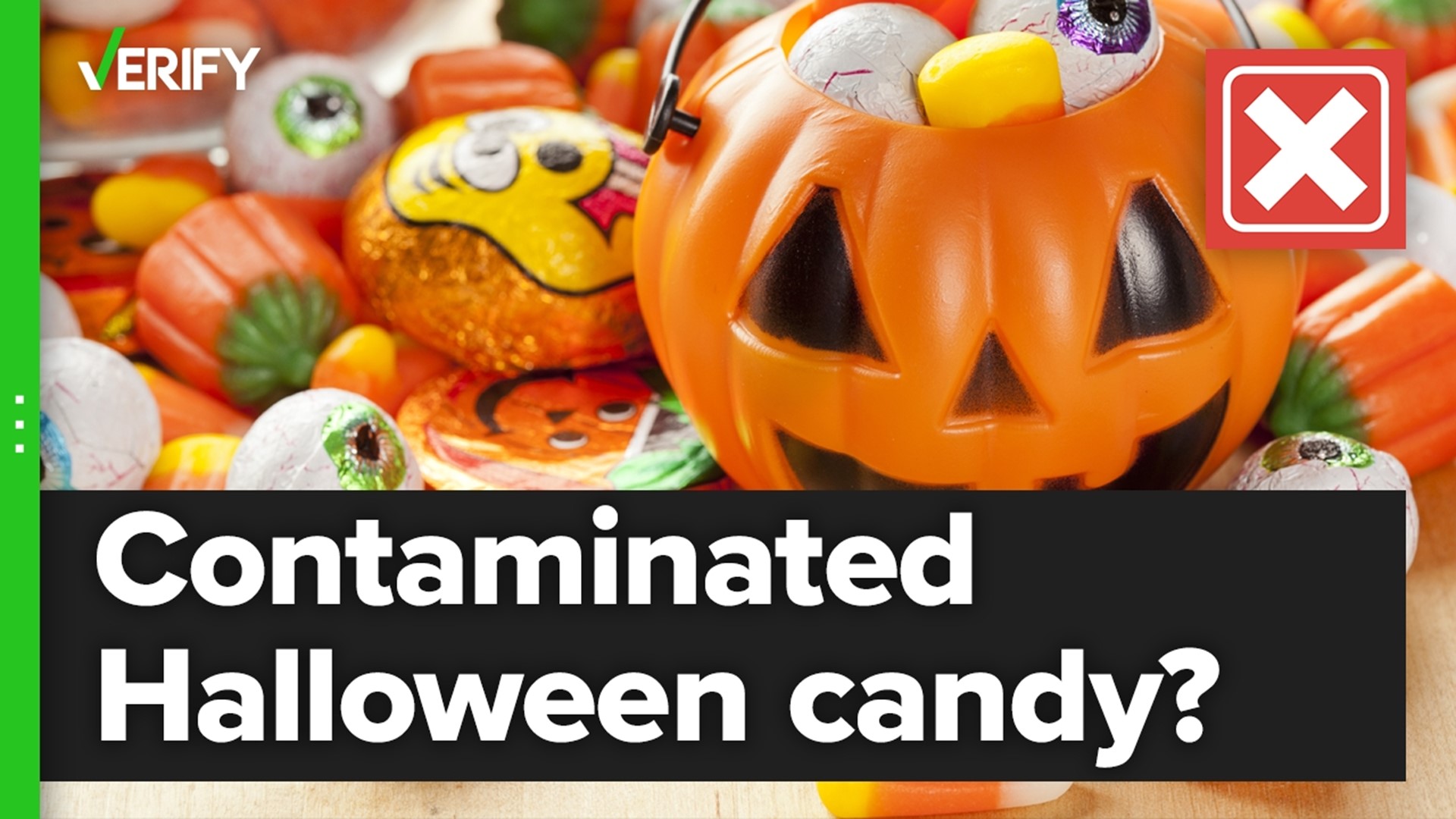Halloween, as we know it today in the U.S., became widely popular in the 1950s when communities across the country tried to ramp down the vandalism and mischief that had been previously associated with the holiday. Now, every year on Oct. 31, millions of kids nationwide dress up in a variety of fun or creepy costumes and go trick-or-treating in their neighborhoods.
In the weeks before Halloween each year, local news reporters and police departments often warn parents about the possibility of people tampering with their kids’ Halloween candy. This has left many parents worrying about what could potentially end up in their child’s trick-or-treat bag. But is there any truth to these claims?
THE QUESTION
Are legitimate reports of contaminated Halloween candy common?
THE SOURCES
- National Confectioners Association
- Erik Altieri, executive director of NORML
- Joel Best, professor of sociology and criminal justice at the University of Delaware
- Lt. Ryan Bessette, public information officer at the Waterbury Police Department
- Wayne Bird, police chief of the Williamsburg Police Department
- Frederick Harran, director of public safety at the Bensalem Police Department
- Chris Gaddis, assistant chief of police at the Burlington Police Department
- Jon Reed, chief of police at the Winchester Police Department
- Gloucester Township Police Department
THE ANSWER
No, legitimate reports of contaminated Halloween candy are not common.
WHAT WE FOUND
Joel Best is a professor of sociology and criminal justice at the University of Delaware. He says the theory of giving contaminated treats to children during trick-or-treating was first referred to as “Halloween sadism” in the 1970s.
“Halloween sadism is the idea that there are maniacs who try to harm children by passing out contaminated treats — razor blades in apples, pins in candy bars, poisons in treats, and so on,” said Best.
In 1985, Best co-authored an article that reviewed the press coverage of Halloween sadism from 1958 to 1984 in four U.S. newspapers: The New York Times, the Los Angeles Times, the Chicago Tribune, and the Fresno Bee. He later published a book that featured an updated version of the article in 1990. He told VERIFY that he has not found one incident of a child being injured or killed from contaminated candy after trick-or-treating on Halloween since he first began compiling his data.
“I've been studying this for a long time and I can't find any evidence that any child has ever been killed or seriously hurt by a contaminated treat picked up in the course of trick-or-treating. I think that this is best understood as a contemporary legend,” said Best.
Best says contemporary legends, which are also referred to as urban legends or urban myths, are stories that are told as true, even though there may be little or no evidence that the events in the stories have ever occurred, and are often ways people express anxiety. He says concerns about Halloween sadism tend to be particularly acute in years when some sort of terrible recent crime has heightened public fears.
“This year we're having another round of THC stuff. The first round that I was aware of was after whatever the year was when Colorado first had legal dope, and you know, it went away and then it came back again like two or three years ago, and apparently, it's back again this year,” said Best.
In September, the Bensalem Police Department in Pennsylvania confiscated 50 marijuana-laced edibles that mimicked popular snack brands. According to Frederick Harran, who serves as the director of public safety for the Bensalem Police Department, the incident was not connected to Halloween. Nevertheless, the department warned parents to keep an eye out for the look-a-like bags this Halloween. Harran told VERIFY this warning was out of an abundance of caution. He confirmed the Bensalem Police Department hasn’t received any reports of contaminated candy being given to children in the past.
Erik Altieri, the executive director of NORML, an advocacy group lobbying for marijuana law reform, told VERIFY that it’s highly unlikely that people would give kids THC-laced treats on Halloween.
“Children receiving marijuana-laced Halloween candy is one of those urban myths that just seems to never really die. But the real fact of the matter is, you're more likely to summon Beetlejuice on Halloween by saying his name several times than finding marijuana edibles in your kid's Halloween bag from trick-or-treating,” said Altieri.
According to Altieri, marijuana edibles are way more expensive than the average bag of Halloween candy that a person can buy at their local grocery store.
“A bag of Snickers snack-size bars costs you under $10 for many, many pieces of candy, where you could be paying $15, $20, or $40 for one edible, depending on where you are,” said Altieri. “So from an economics perspective, it makes absolutely no sense that someone would go out there and spend hundreds and hundreds of dollars on marijuana edibles just to give them to kids who then walk away and they never see again.”
Altieri says in states where marijuana is legal, it is pretty easy to spot if a bag of candy is actually a marijuana edible because there are strict regulations in place on how they must be sold.
“They have to have specific stamps, in many cases, right on the cookie or candy bar. There will be a stamp of the warning sign with a pot leaf on it or something, whatever the state uses to notify people that this is in fact a marijuana edible,” said Altieri. “Generally, they come in child-safe packaging. The dosage is controlled. It would be pretty identifiable should somehow that product end up in with your children's other candy.”
The National Confectioners Association started a Halloween Candy Hotline in 1982 for police and poison control centers to report contaminated candy in the U.S. In an online article published in 2013, former NCA spokesperson Susan Smith told ABC News the organization shut down the hotline in 2012 because “tampering is extremely rare, and we don't even track it anymore because police just aren't seeing it.” A current NCA spokesperson also confirmed with VERIFY they no longer run the hotline due to this reason.
“We don’t do any research on this, but we anecdotally agree that these are typically isolated, rare, false reports and/or hoaxes,” the spokesperson said in an email.
The VERIFY team reached out to several police departments across the country that previously received reports of potentially contaminated Halloween candy over the last decade.
On Nov. 1, 2019, a 37-year-old man in Waterbury, Conn., was arrested after parents found razor blades at the bottom of their kids’ trick-or-treat bags. The children were not injured or hurt, but police say Jason Racz was charged with risk of injury to a minor, reckless endangerment and interfering with a police officer. Lt. Ryan Bessette, a public information officer at the Waterbury Police Department, told VERIFY Racz is still awaiting disposition from court.
“We are not aware of any incidents prior or since that incident occurred,” said Bessette. “Historically, we have not had issues with any contaminated Halloween candy.”
Meanwhile, in another Nov. 2019 incident, the Burlington Police Department in Burlington, N.C. shared on its Facebook page that it had been made aware of a social media post stating that a family member believed a child had been exposed to contaminated candy they acquired on Halloween.
Assistant police chief Chris Gaddis told VERIFY the incident involved a child becoming ill after attending a public Halloween event and later eating candy they received there. The family admitted that the child had also eaten other candy from other locations and other foods. Gaddis says the parents took the child to a local emergency room where the child was treated and later released from the hospital without further treatment.
“We became aware when a relative began using social media platforms to post unconfirmed assumptions of the cause of the child’s temporary illness. We made the post to help slow down inaccurate information that was being shared and to help bring clarity to the situation for our community,” said Gaddis. “We reached out to the family and local health groups to investigate. We never confirmed that a crime or exposure to contaminated Halloween candy occurred. The family wished not to pursue any additional assistance.”
Gaddis says the department did not receive any reports of similar incidents in October or November 2019 and says they haven’t received any since then.
In Whitley County, Ky., a local news station reported in November 2019 that police were warning parents about contaminated Halloween candy after CBD gummies were allegedly passed out to kids who were trick-or-treating. Police Chief Wayne Bird confirmed with VERIFY that the incident was isolated and no arrests were made. He says the department has not had any further reports of similar incidents in the area.
In November 2015, police in Winchester, Indiana, shared on their Facebook page that they had received reports of people placing razor blades in candy bars on Halloween. Chief Jon Reed of the Winchester Police Department told VERIFY that report was determined to be a hoax. He says the department has not received any similar reports since then.
The Gloucester Township Police Department responded to a home in Blackwood, N.J., after a man reported he had found four sewing needles in four separate pieces of candy from trick-or-treating on Halloween in November 2015. After an investigation, police say it was discovered that the man had made up the story and had placed the needles in the candy bars himself. He was arrested and charged with making a false police report.
While finding contaminated Halloween candy may not be something parents have to worry about, according to the National Safety Council (NSC), children are more than twice as likely to be hit or killed by a car on Halloween than any other day of the year. On its website, the NSC shares a few tips on how to keep your kids safe when they’re out trick-or-treating.
More from VERIFY: Yes, it’s generally safe for wildlife to eat discarded pumpkins












